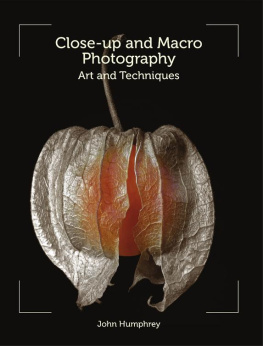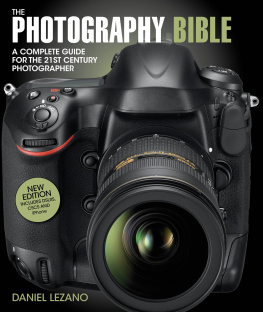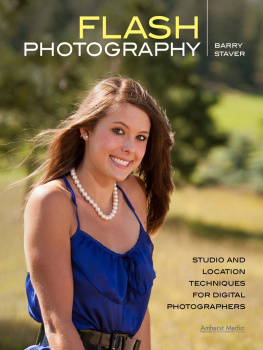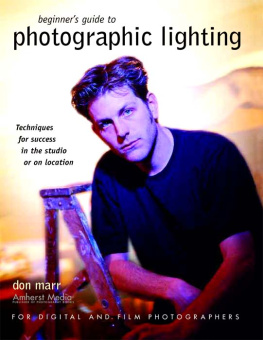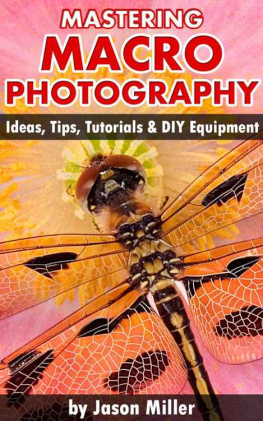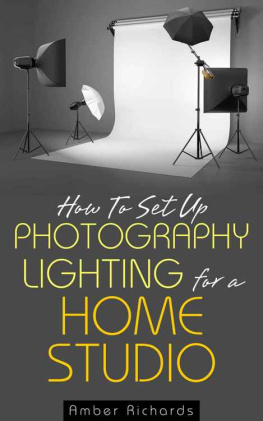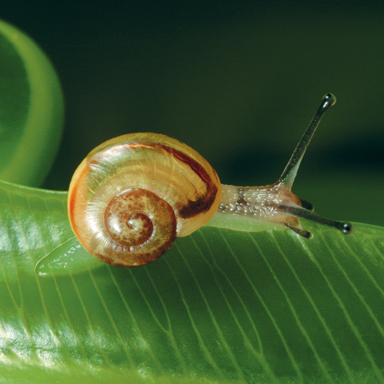Closeup Shooting
Closeup Shooting
A Guide to Closeup, Tabletop, and Macro Photography
Cyrill Harnischmacher
Editor: Gerhard Rossbach Translation: Christina Schulz Copyeditors: Don Lafler, Samuel Dixon
Layout and Type: Cyrill Harnischmacher Cover Design: Helmut Kraus, www.exclam.de
Printer: Friesens Corporation, Altona, Canada Printed in Canada
ISBN 978-1-933952-09-3
1st Edition
(c) 2007 by Rocky Nook Inc.
26 West Mission Street Ste 3
Santa Barbara, CA 93101
www.rockynook.com
First published under the title close-up shooting (c) Cyrill Harnischmacher, Germany 2006
Library of Congress Cataloging-in-Publication Data
Harnischmacher, Cyrill.
[Close-up shooting. German]
Closeup shooting : a guide to closeup, tabletop, and macro photography/
Cyrill Harnischmacher ; [translation, Christina Schulz]. -- 1st ed.
p. cm.
ISBN 978-1-933952-09-3 (alk. paper)
1. Photography, Close-up. I. Title.
TR683.H3713 2008
778.324--dc22
2008011237
All product names and services identified throughout this book are trademarks or registered trademarks of their respective companies. They are used throughout this book in editorial fashion only and for the benefit of such companies. No such uses, or the use of any trade name, is intended to convey endorsement or other affiliation with the book. No part of the material protected by this copyright notice may be reproduced or utilized in any form, electronic or mechanical, including photocopying, recording, or by any information storage and retrieval system, without written permission of the copyright owner.
While reasonable care has been exercised in the preparation of this book, the publisher and authors assume no responsibility for errors or omissions, or for damages resulting from the use of the information contained herein.
This book is printed on acid-free paper.
My thanks go to Urte, Tabea, Jona, Ingrid, Kai, Bettina, and to all those who have contributed to this book one way or another.
Moss. 1/125 sec at f/13; 50mm macro lens with 2x converter; off-camera flash with softbox. The moss was sprayed with water shortly before this image was taken.
Insights into New Worlds
One of the most fascinating areas of photography is closeup photography. Each step taken further into its depths is a step into a new world. Crystal clear globes may appear to hang weightless in space and seem to defy the laws of physics; we meet bizarre creatures that appear as though they came from other planets; and we discover master achievements in architecture which any engineer or architect would envy. This world lies directly before our eyes, yet it is so small and frequently so fleeting we cannot perceive it solely with our senses. Thus, closeup photography can be a journey into the unknown where new discoveries are constantly made, even after years of exploration. By using light, aperture, and creativity combined with the imagination of the photographer, new visual worlds can be created. Even common, everyday objects can be depicted in an exclusively unique way. Macro photography is defined as: The making of photographs in which the object is either unmagnified or slightly magnified up to a limit often of about 10:1. Also, Macro photography is defined as any photo in which the subject has at least a 1:1 ratio with the photo negative, meaning that the image on the negative of the subject is exactly the same size or larger than the real life subject. Closeup photography is defined as: A photograph taken at close range. There is no predefined demarcation of exactly where the closeup range ends and where macro photography begins. The term closeup encompasses not only closeup photography, but macro and tabletop photography as well. Therefore, in the interest of consistency, the term closeup will be used in lieu of alternating between closeup, tabletop, and macro. Closeup and tabletop photography also differ from macro photography in that the attraction of closeup and tabletop photography is more about designing, whereas macro photography is more about discovery. The image of a butterfly, which fills the picture format, will be considered by most people macro, even when the magnification is 1:3. A box of matches shown at the same ratio would more likely be considered a closeup image. The size of the objects being photographed, in conjunction with our habits of seeing, shape our perceptions too extensively to allow for a firm delineation between the two. The reason for this is based on our knowledge of the size of the box of matches. We can compare it to our learned notion of its size, whereas butterflies exist in many different sizes. However, my intention is not to elaborate on standard sizes in this book, but rather to focus on the opportunities available in the creative handling of modern technology in closeup photography.
In addition to covering the photographic and technical basics, a special emphasis is placed on how to handle lighting. Sometimes very minor lighting changes are necessary to make the leap from simply taking pictures to consciously creating great photographs.
Cyrill Harnischmacher
The Basics
In order to achieve consistently pleasing results, you should become familiar with some of the basics, and learn how to use them purposefully in the creative design of your images. We will first take a look at the terms which recur in the art of closeup photography.
Magnification Ratio
The magnification ratio describes the relationship between the actual size of an object and the size of its image on the film or sensor. A magnification ratio of 1:1 is reached when the object is reproduced in its actual size. This means 1cm in nature corresponds precisely to 1cm on the film or sensor, independently of the format used. When using a ratio of 2:1, the object will be illustrated twice as large as its natural size. Therefore, at a 2:1 ratio, 0.5cm in nature corresponds to 1cm on the film or sensor.
Circles of Confusion
When a lens is focused, only those points which lie in the plane of focus will appear sharp on the film and/or sensor. All other areas of the image will not be shown as precise points, but rather as circles, called circles of confusion. To a certain degree, our perception will accept these circles as sharply focused. If the size of the circles exceeds this degree, we interpret them as out of focus. The camera format dictates how large the circles can be, and still be perceived as sharply focused. The shape of the circles of confusion has no influence on depth of field; the shape of the circles are determined by the shape and number of shutter segments. Ideally, the shutter segments form a circular shaped aperture opening. This rather subjective measurement of quality is called Bokeh.
Next page

